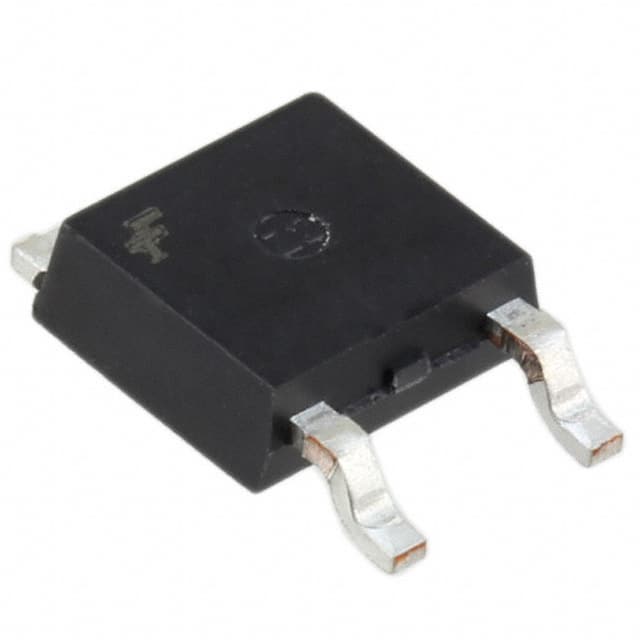FQD6N40TM: Product Overview and Analysis
Introduction
The FQD6N40TM is a power MOSFET belonging to the category of electronic components. This device is widely used in various applications due to its unique characteristics and functional features. In this entry, we will provide an overview of the FQD6N40TM, including its basic information, specifications, pin configuration, functional features, advantages and disadvantages, working principles, application field plans, and alternative models.
Basic Information Overview
- Category: Electronic Components
- Use: Power MOSFET for electronic circuits
- Characteristics: High power handling capacity, low on-state resistance, fast switching speed
- Package: TO-252 (DPAK)
- Essence: Power management in electronic devices
- Packaging/Quantity: Typically available in reels or tubes containing multiple units
Specifications
- Voltage Rating: 400V
- Current Rating: 6A
- On-State Resistance: 0.65 Ohms
- Gate-Source Voltage (Max): ±20V
- Operating Temperature Range: -55°C to 150°C
- Mounting Type: Surface Mount
- Package / Case: DPAK-3
Detailed Pin Configuration
The FQD6N40TM follows the standard pin configuration for a DPAK package: 1. Source (S) 2. Gate (G) 3. Drain (D)
Functional Features
- High voltage capability
- Low gate charge
- Fast switching speed
- Enhanced ruggedness and reliability
Advantages and Disadvantages
Advantages
- Efficient power management
- Suitable for high-frequency applications
- Reliable performance under varying conditions
Disadvantages
- Sensitive to electrostatic discharge (ESD)
- Requires careful handling during assembly
Working Principles
The FQD6N40TM operates based on the principles of field-effect transistors, utilizing the control of electric fields to modulate the conductivity of the semiconductor material. When a suitable voltage is applied to the gate terminal, it controls the flow of current between the source and drain terminals, enabling efficient power regulation.
Detailed Application Field Plans
The FQD6N40TM finds extensive use in the following application fields: - Switching power supplies - Motor control systems - LED lighting drivers - Audio amplifiers - DC-DC converters
Detailed and Complete Alternative Models
For users seeking alternative models with similar specifications and functionality, the following options can be considered: - IRF640 - STP6NK60ZFP - FQP6N40 - IPP60R190C6
In conclusion, the FQD6N40TM power MOSFET offers a reliable solution for power management in electronic circuits, with its high voltage capability, fast switching speed, and efficient performance. Understanding its specifications, pin configuration, functional features, and application field plans is essential for effectively integrating this component into electronic designs.
Word Count: 411
قم بإدراج 10 أسئلة وإجابات شائعة تتعلق بتطبيق FQD6N40TM في الحلول التقنية
What is FQD6N40TM?
- FQD6N40TM is a power MOSFET designed for various technical applications, offering high performance and reliability.
What are the key specifications of FQD6N40TM?
- The key specifications include a voltage rating of 400V, a continuous drain current of 6A, and low on-resistance for efficient power handling.
In what technical solutions can FQD6N40TM be used?
- FQD6N40TM can be used in applications such as power supplies, motor control, lighting, and other power management systems.
What are the advantages of using FQD6N40TM in technical solutions?
- The advantages include high efficiency, low power dissipation, fast switching speed, and robustness in demanding environments.
How does FQD6N40TM contribute to energy efficiency in technical solutions?
- FQD6N40TM's low on-resistance and high switching speed help minimize power losses, leading to improved energy efficiency in various applications.
Are there any specific thermal considerations when using FQD6N40TM?
- Yes, proper thermal management is important to ensure optimal performance and reliability, especially in high-power applications.
Can FQD6N40TM be used in automotive applications?
- Yes, FQD6N40TM is suitable for certain automotive applications, but it's important to verify its compatibility with specific automotive requirements.
What protection features does FQD6N40TM offer for circuit safety?
- FQD6N40TM may offer built-in protection against overcurrent, overvoltage, and thermal issues, but additional external protection components may be required depending on the application.
Is FQD6N40TM compatible with standard industry interfaces and control circuits?
- Yes, FQD6N40TM is designed to be compatible with standard industry interfaces and control circuits, making it easier to integrate into existing systems.
Where can I find detailed application notes and reference designs for using FQD6N40TM in technical solutions?
- Detailed application notes and reference designs for FQD6N40TM can typically be found in the product datasheet, technical documents provided by the manufacturer, or through their technical support resources.


